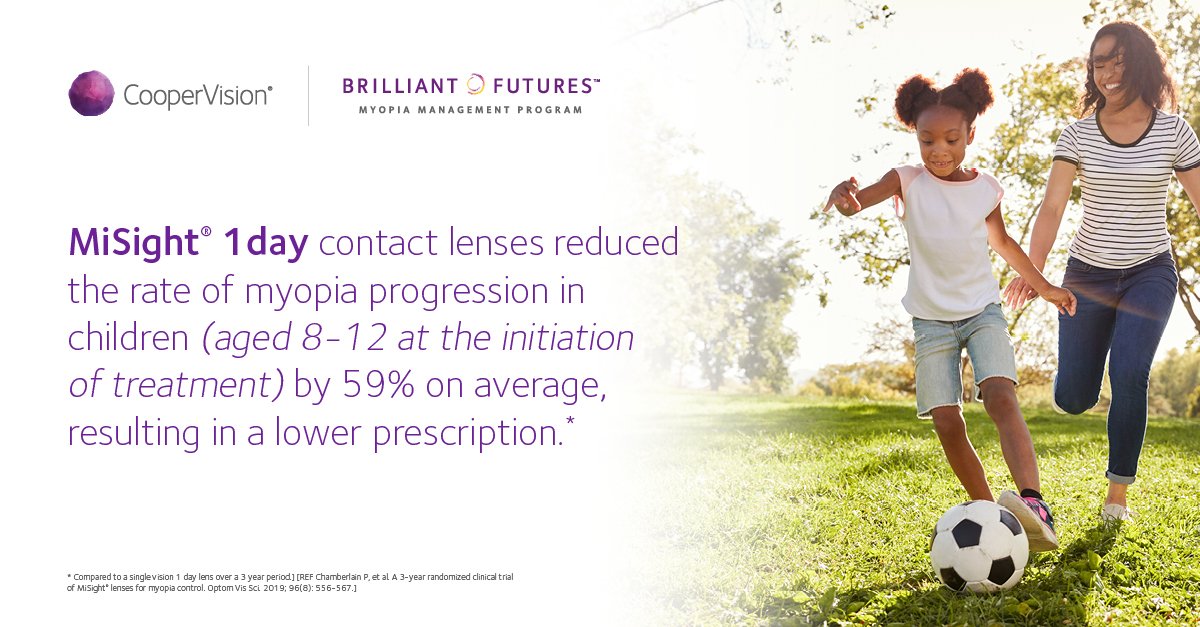What is Myopia?
Myopia is more commonly known as nearsightedness, where distance objects are blurry. Myopic eyes are longer than non-myopic eyes. The longer the eye, the worse the vision. The liklihood of children developing myopia increases 1 in 2 when both parents are myopic, 1 in 3 when one parent has myopia, and 1 in 4 when neither parent has myopia. Research is showing that increased time indoors reading and using devices such as tablets and smartphones may also influence the development of myopia. It is becoming more widespread- today more than 40% of Americans have myopia compared to 25% in the early 1970s. That number is continuing to increase, especially among school-age children. A study recently done during the pandemic (and safer at home orders) also confirmed this.
What is Myopia Management?
Myopia Management is the process by which eye care providers work to limit the amount of myopia (nearsightedness) that develops in young eyes. This can be accomplished using several different methods, which we will discuss in greater detail below.
Why should we consider Myopia Management?
Myopia, or nearsightedness, occurs when light entering the eye focuses in front of the retina. This happens because the eye grows too long (axial length). The eye can continue to lengthen until around age twenty. If a child starts being moderately nearsighted when young, and continues to progress as they age and the eye grows, the potential for significant myopia to develop is great. That can lead to increased risk of retinal detachment, myopic maculopathy, glaucoma, and cataracts.
Treatment is intended to reduce the progression of myopia both so that the child doesn't develop a very strong prescription, but also to reduce the risk of eye diseases later in life.
How do I know if my child is a candidate for Myopia Management?
Your doctor will be able to help assess whether Myopia Management could benefit your child. General guidelines state that a child 6 or under who is slightly hyperopic (farsighted) is low risk, someone less hyperopic or starting to be myopic at age 6 is medium risk, and a child who has been diagnosed with myopia between ages 8 and 12 is high risk for progression.
Therapeutic Treatment Options for Myopia Management
The first option we will discuss is specially designed multifocal contact lenses. Our office is one of the few in the area fitting MiSight lenses, the first FDA approved contact lens for treating myopia progression. This is a daily disposable lens, which is especially great for kids. The advantages of a daily disposable are that they are a healthier replacement modality (fresh lenses every day!), and as parents you don't have to worry about how well they are cleaning and caring for the lenses. The multifocal contact lens uses correction zones and treatment zones in the lens to slow the growth of the eyeball (length). This means they allow the child to have vision correction now while helping the eye resist growing longer to preserve vision for the future. Studies have shown these lenses can reduce the progression of myopia by up to 59%!

A second treatment option is atropine drops. These drops dilate the eyes, and a specially formulated low dose is used nightly before bed. The child would still need to wear their glasses during the day, but this has been shown to decrease the progression of myopia. Potential side effects include mild near blur.
How can I learn more or get started with Myopia Management?
Please contact our office at 615-758-2344 to schedule a Myopia Management consultation or email This email address is being protected from spambots. You need JavaScript enabled to view it..
It is exciting to have new science and technology at our fingertips to impact both how our children see, and the health of their eyes, later in life!
To read more about the FDA approval of MiSight, click here

